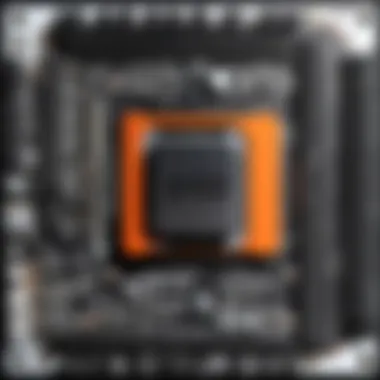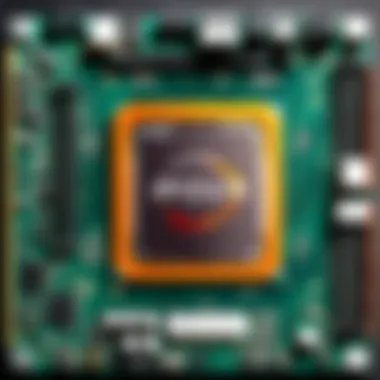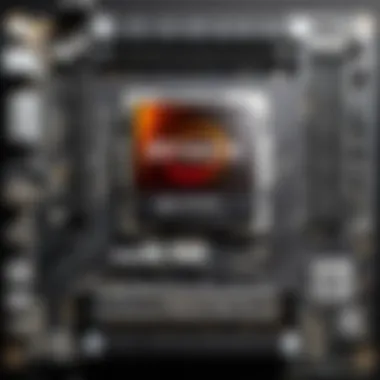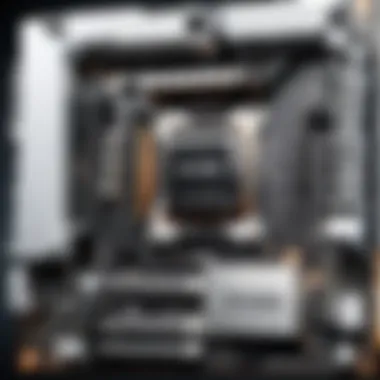In-Depth Analysis of Ryzen Motherboards: Architecture & Performance


Intro
The landscape of computing hardware has evolved significantly, particularly with the rise of Ryzen processors. For enthusiasts and professionals alike, understanding the role of motherboards in this ecosystem is crucial. Motherboards serve as the backbone of a computer system, connecting various components and influencing overall performance directly. This article aims to demystify Ryzen motherboards by examining their architecture, compatibility with various Ryzen processors, and performance metrics.
Ryzen processors, developed by AMD, are designed around a specific architecture called Zen. The innovations in chip design and manufacturing processes have led to an era where Ryzen motherboards play a pivotal role in maximizing the capabilities of these processors. With a vast array of chipset options available, each tailored to different user needs, selecting the right motherboard is no simple task. This discussion will delve into the technical specifications of various Ryzen motherboards, highlighting how architecture and features correlate with performance, especially in demanding environments such as gaming and professional applications.
Additionally, market trends are shifting as more users evaluate their motherboard choices based on how well these components support future Ryzen technologies. From entry-level to high-end options, each motherboard has unique offers that cater to diverse user requirements. We will explore these trends and provide insights into effective selection strategies for those looking to invest in Ryzen motherboards. In doing so, this article synthesizes technical insights and practical considerations, aiming to equip readers with the knowledge needed for informed decisions in their hardware investments.
Preface to Ryzen Motherboards
The exploration of Ryzen motherboards is fundamental for understanding the landscape of modern computing. As the backbone of any PC system, motherboards play a crucial role in determining performance, compatibility, and the overall user experience. In the case of Ryzen, a line of processors by AMD, the choice of motherboard is critical. This section aims to highlight the importance of Ryzen motherboards by addressing specific elements, benefits, and considerations that are essential for informed decision-making.
Understanding the Ryzen Platform
Understanding the Ryzen platform begins with its architecture. Ryzen processors utilize the AM4 socket, which has become a significant standard for compatibility across various generations of processors. The key architectural features of Ryzen imply a focus on multi-threaded performance, making it especially attractive for gamers and professionals alike. It provides excellent support for high core and thread counts, which translates to better multitasking capabilities.
The architecture also integrates the Zen microarchitecture. Generations of Zen have progressively improved performance and efficiency. For example, the transition from Zen to Zen 2 brought noticeable gains in IPC (Instructions Per Cycle) performance, resulting in a worthwhile upgrade for many users. This incremental enhancement makes it vital to choose a motherboard that can unlock the full potential of the respective Ryzen generation, ensuring that the enhancements in architecture reflect in the overall system performance.
The Role of Motherboards in Computing
Motherboards serve as the central hub connecting all components of a computer. They are essential for effective communication between the processor, memory, storage, and other hardware elements. When it comes to Ryzen-based systems, the motherboard must support specific functionalities, such as power delivery and data transfer.
Motherboards also dictate the expansion options available to users, whether that is through PCIe slots for graphics cards or M.2 slots for SSDs. The quality of the motherboard’s power delivery system can significantly influence stability and performance, especially when overclocking.
Furthermore, a well-designed motherboard can improve thermal management. This aspect is vital to maintain optimal operating conditions during intensive tasks, such as gaming or content creation. The role of motherboards is multidimensional; they must support current technology while being capable of evolving with upcoming advances in the Ryzen ecosystem.
"A good motherboard does not only focus on current components, but ensures future compatibility with evolving technologies."
Ryzen Processor Lineup
The Ryzen processor lineup serves as a crucial element in the discussion of Ryzen motherboards. Understanding this lineup helps in making well-informed decisions when selecting a motherboard, as compatibility between processors and motherboards directly affects performance and system stability. Different generations of Ryzen processors bring unique architectural advancements and performance improvements. Moreover, knowing the specific capabilities of each processor generation can highlight the features to seek in a compatible motherboard.
Overview of Ryzen Generations
The Ryzen processor families include several generations, each showcasing varying enhancements in technology, core counts, and clock speeds. The initial Ryzen processors debuted in 2017, introducing the Zen microarchitecture. This architectural leap marked AMD's return to competitiveness against rival processors. Subsequent generations—Zen+, Zen 2, and Zen 3—followed, bringing further performance refinements and efficiency improvements.
- Zen Architecture: The foundation for the first Ryzen series, focusing on multi-threaded performance and cost efficiency.
- Zen+ Architecture: An iterative update offering improved clock speeds and better power management, enhancing overall performance at similar power levels.
- Zen 2: This series brought significant gains in IPC (Instructions per Clock) and supported higher core counts, catering to heavy computing tasks.
- Zen 3: Lauded for its outstanding performance, this generation maximizes single-threaded performance, ideal for gaming and other demanding applications.
These generations impact the selection of motherboards, as each comes with specific features and requirements that motherboards must support.
Processor Compatibility with Motherboards
Compatibility between Ryzen processors and their respective motherboards hinges on several factors such as socket type, chipset features, and firmware. Most Ryzen processors utilize the AM4 socket, which has remained consistent across multiple generations. However, only certain chipsets are designed to support specific processor families.
Here are key aspects of compatibility:
- Socket Type: All Ryzen processors from the first generation to the latest utilize the AM4 socket. However, not all AM4 motherboards support every generation.
- Chipset Features: Chipsets like B350, B450, and X570 equip motherboards with varying levels of performance features including power delivery and overclocking support. For example, B450 may suffice for basic users, while X570 offers advanced features for enthusiasts.
- BIOS Updates: It's essential to check for BIOS updates. Many older motherboards can support newer Ryzen processors with a simple firmware update.
"It is crucial to verify motherboard specifications to ensure the selected board meets all processor requirements."
Understanding compatibility ensures that users achieve optimal performance without the risk of hardware limitations.
Chipsets for Ryzen Motherboards


Understanding chipsets is vital when considering Ryzen motherboards. Chipsets serve as the backbone of motherboards, determining the functionalities and features available for users. The appropriate chipset can enhance overall system performance and user experience. It connects the processor, memory, and additional components, impacting device capabilities. Therefore, selecting a compatible chipset can optimize the functionality of Ryzen processors.
Choosing the right chipset affects various aspects of computing, including:
- Expansion Options: Higher-end chipsets often provide more PCIe lanes, enhancing graphics and storage capabilities.
- Supported Features: Chipsets dictate supported technologies like USB standards, overclocking features, and memory speeds.
- Upgrade Path: A future-proof chipset can allow users to upgrade their processors without needing an entire motherboard replacement.
Ultimately, the chipset can determine the potential of a Ryzen system, making it a key aspect to explore.
AM4 Chipset Variants Explained
The AM4 chipset is designed specifically for Ryzen processors, confirming compatibility across a wide range of models. Several variants of the AM4 chipset exist, each catering to different user needs and performance levels. The variants include B350, X370, B450, X470, B550, and X570. Each selection presents unique features and capabilities:
- B350: An entry-level option that supports overclocking and basic connectivity.
- X370: A more advanced choice that includes robust power delivery options for serious overclockers.
- B450: Offers enhancements over B350, adding support for faster memory speeds.
- X470: A premium option with advanced features, suitable for high-performance gaming rigs.
- B550: Provides PCIe 4.0 support while still maintaining a favorable price-performance ratio.
- X570: A top-tier chipset that offers extensive connectivity options and overclocking capabilities, ideal for enthusiasts.
Each chipset variant has its pros and cons. Therefore, understanding the hierarchy and features of each helps users make informed decisions.
Features of Chipsets
Chipsets for Ryzen motherboards boast a wide array of features that cater to varying user requirements. Among the many notable features, the following are critical in guiding choices:
- PCIe Lanes: Determines the number and version of modern peripherals that can be connected, directly influencing gaming and computing capabilities.
- USB Ports: Chipset designs include different USB standards and numbers, impacting peripheral connectivity, including high-speed data transfers and charging capabilities.
- Networking Options: Chipsets like the X570 integrate advanced networking technology, such as Wi-Fi 6 and 10Gb Ethernet, enhancing online gaming and data transfer.
- Advanced Power Management: Modern chipsets offer better efficiency, reducing heat generation and potentially prolonging hardware longevity.
In summary, the chipset not only influences immediate functionality but also the overall upgrade potential of a Ryzen system. Appropriate selection ensures that users get the most out of their Ryzen processors.
Key Features of Ryzen Motherboards
Understanding the key features of Ryzen motherboards is essential for anyone interested in maximizing system performance. The motherboard serves as a backbone for all components in a computer, influencing overall functionality, power management, and connectivity. For gamers, technology enthusiasts, and professionals, selecting the right motherboard can dictate how effectively other hardware performs. An ideal motherboard enhances throughput, reduces bottlenecks, and accommodates upgrades without undue complexity.
Expansion Slots and Connectivity
Expansion slots are crucial for upgrading and adapting a system to varied needs. Ryzen motherboards typically feature PCIe slots that support graphics cards, SSDs, and other peripherals. Most modern Ryzen boards use PCIe 4.0 technology, which offers increased bandwidth compared to earlier versions. This is particularly notable for gamers and content creators who require substantial data transfer rates.
Additionally, a variety of expansion slots can cater to specialized hardware such as sound cards and capture cards. Users must consider the number and type of expansion slots available on a motherboard when selecting it. This ensures compatibility with future upgrades.
Furthermore, connectivity options matter significantly. USB ports of different generations, Ethernet networking capabilities, and even integrated Wi-Fi create flexible usage scenarios.
Power Delivery Systems
Power delivery systems must be robust to support Ryzen processors efficiently. Quality motherboards use high-quality components to manage power distribution effectively. This ensures stability, especially under heavy loads. A strong power delivery system can also prolong the hardware's lifespan and improve performance during overclocking.
Notably, the VRM (Voltage Regulator Module) design is a vital aspect of the power delivery system. Ryzen motherboards with superior VRMs allow for more precise voltage control, which increases the overclocking potential of the CPU. Understanding the power requirements of your processor will guide your motherboard choice.
Integrated Audio and Networking
Integrated audio systems in Ryzen motherboards provide decent sound quality for most users. However, audiophiles or professionals may opt for dedicated sound cards to enhance audio performance. It’s essential to verify the audio chip specifications when selecting a motherboard if sound quality is a priority.
Networking capabilities have evolved significantly over the years. Many Ryzen motherboards come with integrated Ethernet, while some models offer wireless connectivity options. In competitive gaming, stable and fast network connections are vital. So, checking compatibility with the latest Wi-Fi standards and whether there are multiple Ethernet ports can ensure a more reliable online experience.
"Choosing the right motherboard is not just about compatibility; it's about finding the perfect balance of features that enhances performance."
In summary, the key features of Ryzen motherboards—expansion slots, power delivery systems, and integrated audio and networking—should be carefully considered in the context of individual computing needs. By prioritizing these aspects, users can optimize their systems for performance, future upgrades, and practical use.
Performance Metrics


Performance metrics are crucial when it comes to evaluating the efficiency and capability of Ryzen motherboards. These metrics provide a quantifiable way to gauge how well a motherboard can handle various workloads, particularly for applications that require significant processing power. By understanding these performance indicators, users can make informed decisions, ensuring their ryzen systems deliver the highest standard of performance relative to their intended use.
Benchmarking Ryzen Motherboards
Benchmarking is a systematic method used to assess the performance of hardware components in a controlled environment. For Ryzen motherboards, benchmarking helps in identifying how well they stack up against competitors and previous generations.
Some common benchmarks include:
- CPU Performance: Evaluated using tools like Cinebench and Geekbench, these tests measure how effectively the motherboard manages processing tasks.
- Memory Bandwidth: Applications like AIDA64 help analyze the data transfer speed between RAM and CPU, which is essential for gaming and high-performance tasks.
- Gaming Performance: Tools such as 3DMark provide insights into how well a motherboard can support GPU-intensive applications.
Benchmarking gives valuable insights into stability and potential bottlenecks. It also helps in assessing temperature management and power consumption. A motherboard that scores high in benchmarks often signifies robust engineering, ensuring better support for future upgrades.
Overclocking Potential
Another critical aspect of performance metrics is overclocking potential. Overclocking refers to running components at speeds higher than their official specifications. This can result in enhanced performance but comes with risks such as increased heat output and potential hardware damage.
Ryzen motherboards often feature built-in capabilities that allow users to modify clock speeds and voltages. For example, features like AMD Precision Boost and Ryzen Master utility allow for intuitive adjustments, enabling enthusiasts to unlock additional performance. The quality of power delivery systems also plays a vital role here, as a well-designed motherboard can handle increased power loads without instability.
However, overclocking leads to heat generation. This necessitates proper cooling solutions to maintain safe operational temperatures. Users should always consider their cooling setup when planning to overclock. Furthermore, not every motherboard provides the same overclocking capabilities. Therefore, selecting a motherboard with a strong track record for stability in overclock situations is essential for maximizing performance.
"Understanding performance metrics is not just about numbers; it is about optimizing your system for the best possible experience."
In summary, when looking at performance metrics for Ryzen motherboards, it is vital to focus on benchmarking and overclocking potential. A comprehensive understanding of these metrics empowers users to elevate their computing experiences, ensuring hardware choices align with specific performance goals.
Selecting the Right Ryzen Motherboard
Choosing the correct Ryzen motherboard is pivotal in ensuring that your computing setup functions optimally. The motherboard acts as the backbone of your system, facilitating communication between the processor, memory, and other components. An inadequate choice can lead to bottlenecks that diminish performance, while the right motherboard amplifies the strengths of your Ryzen processor. This section will dissect various aspects, including user requirements, use cases, and budget considerations, to assist readers in making informed decisions.
User Requirements and Use Cases
Understanding individual user needs is crucial when selecting a Ryzen motherboard. Different users have diverse requirements based on their computing habits and workflows. Here are common use cases that can guide your choice:
- Gaming: For gamers, motherboard features like PCIe slots for high-end graphics cards, sufficient RAM slots for memory upgrades, and robust audio solutions are essential. Additionally, gaming-oriented motherboards often come with enhanced cooling systems to support prolonged sessions.
- Content Creation: Professionals involved in content creation may require motherboards that support multiple GPUs and high-performance storage solutions. Look for options with M.2 slots for SSDs and high DDR4 or DDR5 support. Stability and reliability are critical in these scenarios.
- General Use: For everyday tasks such as browsing and office applications, a basic motherboard with essential features is adequate. Users in this category should focus on budget efficiency without compromising essential functionalities, ensuring compatibility with their Ryzen processor.
Determining what tasks your system will primarily handle can streamline your motherboard selection process. Always consider future requirements as well. Selecting a motherboard with adequate expansion capabilities can save you from future headaches.
Budget Considerations
Budget plays a significant role in selecting a motherboard. It is essential to strike a balance between features and financial feasibility. Consider these guidelines:
- Set a Clear Budget: Before diving into the motherboards' specifications, define how much you are willing to spend. Ryzen motherboards fall within various price ranges, and establishing a budget can streamline your options.
- Prioritize Features: Identify key features that matter most to you. Whether it's enhanced cooling solutions, aesthetic designs, or specific connectivity options, understanding your priorities can help narrow down your choices and prevent overspending on unnecessary features.
- Evaluate Performance vs. Cost: Sometimes, higher-priced motherboards come with features that may not be relevant to your uses. Assess whether the performance gain justifies the added cost. For instance, an advanced overclocking feature may not be essential for general use but could be vital for gaming or heavy tasks.
- Consider Future-Proofing: Investing a bit more initially on a capable motherboard can be worthwhile. Future-proofing allows you to upgrade components without needing a new motherboard for some time.
- Research: Read reviews and comparisons from reputable sources like Wikipedia, Britannica, and forums like Reddit for unbiased opinions that can help in evaluating the best options within your budget.
Ultimately, selecting the right Ryzen motherboard requires careful consideration of your specific needs, computing goals, and financial limits. By aligning your motherboard choice with these factors, you can enhance the overall efficiency and experience of your computing setup.
Trends in the Motherboard Market
The motherboard market is undergoing rapid transformation, influenced by evolving technology, user demands, and competitive pressures. Understanding these trends is essential for anyone looking to invest in Ryzen motherboards, as these considerations significantly affect performance and overall system stability.
Emerging Technologies
New technologies emerge as critical drivers in the motherboard market. This includes advancements like PCIe 5.0 support which provides double the bandwidth compared to PCIe 4.0. Higher speeds benefit data-intensive tasks such as gaming and professional content creation.
Moreover, the integration of faster memory standards such as DDR5 is changing the landscape. DDR5 offers increased bandwidth and improved efficiency. This can lead to substantial performance gains, especially in multitasking and high-performance computing applications. The ability to handle greater memory capacities also allows users to run more demanding applications or games without degrading performance.


Another significant trend is the shift towards enhanced on-board features. Motherboards now often include built-in Wi-Fi 6 and Bluetooth 5.2, improving connectivity without the need for additional hardware. This trend caters to the growing demand for wireless networking capabilities, as more users adopt home office setups and remote working environments.
Consumer Preferences and Innovations
Market preferences exhibit a notable trend towards personalization and user control. Consumers increasingly seek motherboards that offer robust overclocking features. Tailoring performance to meet specific needs is particularly appealing to gamers and tech-savvy users. This includes customizable RGB lighting and variable fan controls that allow enthusiasts to build aesthetically pleasing systems that also perform well.
In addition, there is a growing emphasis on sustainability and energy efficiency among consumers. More buyers are looking for products that balance performance with energy-saving capabilities. This is pushing manufacturers to innovate in ways that improve power delivery systems while reducing overall system power consumption. The result is effcient motherboards that do not sacrifice speed or performance.
"Understanding consumer preferences and emerging technology is crucial for maximizing your investment in Ryzen motherboards."
Lastly, the trend towards integration continues to grow, with manufacturers combining multiple functionalities into single products. This also includes support for various cooling solutions, enabling users to maintain optimal thermal performance without needing extensive aftermarket modifications.
In summary, the motherboard market is characterized by rapid technological advancements and changing consumer demands. Staying aware of these trends helps users make informed decisions regarding which Ryzen motherboard will best suit their needs.
Future of Ryzen Technology
The evolution of Ryzen technology remains a focal point in the landscape of computing. Analyzing future developments offers valuable insights for enthusiasts and builders alike. It will shape what motherboards can achieve concerning integration, performance, and user experience.
Upcoming Ryzen Generations and Chipsets
With each new generation, AMD consistently elevates the bar for performance and efficiency. The anticipated Ryzen 8000 series is expected to usher in several enhancements. Features may include improved power management techniques and higher core counts. These improvements can greatly impact multitasking and gaming performance.
Recent leaks speculate about the introduction of the new Zen 4 architecture. This is expected to deliver noticeable gains in both single-threaded and multi-threaded applications. When paired with advanced chipsets, such as those based on the AM5 socket, the next generation of Ryzen chips will be versatile.
Key chipset features likely to be included are:
- Support for faster DDR5 memory that provides higher speeds and lower latency.
- PCIe 5.0 compatibility, which increases the data transfer rates for graphics cards and SSDs.
- Enhanced thermal management systems to optimize the overall efficiency.
These elements might collectively influence the decision-making process for those considering upgrades or new builds in the near future.
Long-Term Performance Expectations
Understanding future performance expectations is critical for both long-term investments and immediate results. With the Ryzen platform, AMD has built a reputation for exceptional performance longevity. The advancements in architecture and chipset compatibility indicate that users can expect ongoing support for future hardware.
The focus on productivity tools, gaming needs, and heavy applications means that upcoming Ryzen generations could provide solid performance improvements across a spectrum of uses. With each iteration, AMD is likely to enhance:
- Gaming capabilities, allowing for higher frame rates and better overall gaming experiences.
- Creative workloads, benefiting video editing, 3D rendering, and similar tasks.
- Power efficiency, ensuring systems remain cooler and quieter during operation.
In summary, the future of Ryzen technology rocks a promising horizon. As new generations and chipsets emerge, they will influence not only performance but also user expectations for longevity, compatibility, and technological advancements.
Finale
The conclusion serves as a vital component of this article, reflecting on the exploration of Ryzen motherboards across multiple dimensions. In the preceding sections, we articulated various aspects that include architecture, compatibility, and performance metrics. Understanding these factors is crucial for anyone looking to invest in a Ryzen motherboard, as the choices made here directly influence the overall computing experience.
Summarizing Key Insights
In summary, several key insights emerge from our detailed analysis. First, the architecture of Ryzen motherboards is built with manufacturers focusing on supporting a broad range of Ryzen processors, ensuring users have flexibility as they upgrade technology.
- Chipset Variants: The AM4 chipset has proven itself versatile, accommodating various Ryzen generations, including Future Ryzen models, which means the motherboard remains relevant longer.
- Performance Metrics: We discussed benchmarking results that showcase performance under varying loads, demonstrating that the right motherboard enhances not only stability but also speed.
- User Requirements: Different users have different needs. Whether for gaming, creative workloads, or general usage, selecting a suitable motherboard significantly impacts the effectiveness of the chosen Ryzen processor.
Thus, the insights provided help navigate the sometimes labyrinthine choices when selecting hardware and may safeguard against future obsolescence as technology evolves.
Final Thoughts on Ryzen Motherboards
In closing, the landscape of Ryzen motherboards is continuously evolving with advancements in technology. The overall importance of selecting an appropriate motherboard cannot be understated.
Investing in a quality motherboard can maximize the performance of an entire system, ensuring efficient power delivery, ample connectivity options, and solid build quality. Moreover, it lays the foundation for potential upgrades. Users must take into account all factors, from budget constraints to personal use cases. Ultimately, the right choice today sets a proficient stage for tomorrow’s computing needs in a fast-paced digital world.
"Choosing the right motherboard is as critical as selecting the CPU itself. It acts as the backbone of your system."
Ryzen motherboards offer tremendous opportunities, enhancing performance while maintaining versatility. Therefore, thorough research and informed decision-making are essential for users, whether they are esports enthusiasts, tech savants, or gaming fanatics.



